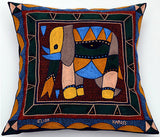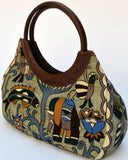African animals represented in Kaross' embroidered art pieces: the African elephant

This post is the first in a series on the African animals represented in Kaross' embroidered art pieces. We decided to start with the most popular animal which is, not surprisingly, the African elephant.
The African elephant in the XiTsonga language
The XiTsonga language has a rich store of proverbs to describe daily life, and elephants feature in many of these. A few favourites are:
An elephant is not borne down by the weight of its tusks - the meaning is that a man should not be borne down by his responsibilities toward his family.
The elephant is the trunk - meaning that without its trunk the elephant is helpless, and similarly, without the necessary tools or people, you cannot do a job as it must be done.
Last but not least: It is an elephant! - the VaTsonga know that marriage is a significant undertaking!
It is natural that elephants (ndlopfu in XiTsonga) and other big 5 animals feature in the Kaross people's language and cultural references, as well as in our embroideries - the Lowveld where Kaross is based is home to numerous game reserves, and the northern section of the internationally renowned Kruger National Park is less than an hour's drive away.
Some interesting facts about the African elephant
 There are many significant aspects about the African elephant, mostly to do with its enormous size and longevity. For instance, an elephant can live to a ripe old age of 60 - 70 years, its heart weighs up to 28kg and beats at only 30 beats per minute.
There are many significant aspects about the African elephant, mostly to do with its enormous size and longevity. For instance, an elephant can live to a ripe old age of 60 - 70 years, its heart weighs up to 28kg and beats at only 30 beats per minute.
The elephant's trunk is an amalgamation of it's nose and upper lip - it can be up to 2 metres long, weigh up to 135kg and contain an estimated 40,000 - 100,000 muscles.
An elephant bull can weigh up to 6.5 tonnes and an elephant cow up to 3.5 tonnes. You would not want to meet either of them on foot in a dark alley!
Along with a visit to Kaross, the Elephant Hall in the Kruger Park is a must-see destination
 Another bodily feature that elephants are widely admired for, and unfortunately poached for, are their tusks, which are basically their two front teeth. The best place to visit to see how impressively large these tusks can become, and to learn more about elephants in general, is the Elephant Hall in the Letaba camp of the Kruger National Park, approximately 140km east of Kaross.
Another bodily feature that elephants are widely admired for, and unfortunately poached for, are their tusks, which are basically their two front teeth. The best place to visit to see how impressively large these tusks can become, and to learn more about elephants in general, is the Elephant Hall in the Letaba camp of the Kruger National Park, approximately 140km east of Kaross.
Back in the late 1970s there were seven large elephant bulls in the Kruger National Park, all with tusks weighing more than 50 kg each. The Park named them the Magnificent Seven and established the Elephant Hall in their honour. As each of these elephants died, their skulls and tusks were retrieved and are displayed in the Hall.
The Elephant Hall is well worth visiting, not only for the impressive tusks (the elephant named Shawu's tusks were the longest at 10 foot and 10.5 foot respectively), but for the many other fascinating facts about elephants that the Park's researchers have gathered.
Why we embroider elephants at Kaross
 At Kaross we admire the strength of the African elephant and are inspired by its magnificent beauty and quiet grace - it is a privilege to live in proximity to these animals and to be able to celebrate them through our designs.
At Kaross we admire the strength of the African elephant and are inspired by its magnificent beauty and quiet grace - it is a privilege to live in proximity to these animals and to be able to celebrate them through our designs.
We would love to hear why you like elephants, or what they signify to you. Visit our Facebook page at karossart, to post your comments.
Browse our online shop for many beautiful cloths, cushions and placemats featuring elephants.
.




